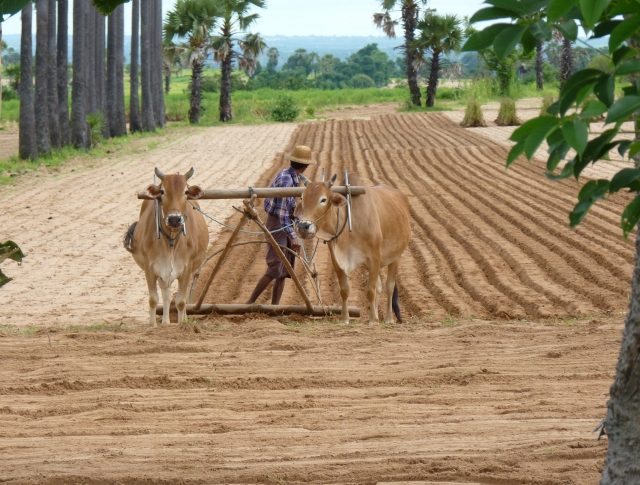

Domesticated livestock have played a pivotal role in the development of human civilizations around the world and continues to be an integral part of human culture, society, and the local and global economy. The history of agriculture is the history of humans breeding seeds and animals to produce traits we want in our crops and livestock.Domestic livestock has contributed to the rise of human societies and civilizations by increasing the amount of food and nutrition available to people in four ways: by providing sources of meat, milk, and fertilizer and by pulling plows. Throughout history livestock have also provided leather, wool, other raw materials, and transport. The availability and husbandry of domesticated plants and animals enabled prehistoric peoples to produce and store sufficient food supplies to develop large, dense societies that did not have to wander in search of food.An efficient and prosperous animal agriculture historically has been the mark of a strong, well-developed nation.
Agriculture permits a nation to store large quantities of grains and other foodstuffs in concentrated form to be utilized to raise animals for human consumption during such emergencies as war or natural calamity. Furthermore, meat has long been known for its high nutritive value, producing stronger, healthier people.
Farmers in Myanmar raise livestock for both food and labour purposes. This includes cattle, water buffalo, goats, sheep, oxen, chickens, and pigs. Oxen and water buffalo are used as draft animals throughout the country, while most cattle are raised in the dryer northern regions. In his Pulitzer-prize winning book Guns, Germs, and Steel, Jared Diamond describes agriculture generated the ample, dependable food supply needed to develop specialized, stratified societies, political organization, writing, and technology. Diamond argues that through close coexistence with domestic animals, people in these societies acquired some immunity to epidemic diseases that devastated other populations. His examples include the Spanish conquest of the Inca and other Native American populations, and the near extermination of the Aboriginal peoples of Australia and other regions by British and other European settlers.
Immediate demand of Myanmar live cattle export to China, Malaysia, and Thailand markets is currently a large priority for many local economies. At the same time new domestic markets for value-added beef products are also developing.
Myanmar’s economy is heavily based on agriculture, and cattle are used throughout the country for draft, particularly by farmers. Livestock products contribute 17% to kilocalorie consumption and 33% to protein consumption globally, but there are large differences between rich and poor countries. Cattle make up the largest livestock group worldwide. Cattle are sometimes used as draft animals, particularly in small-scale farming and in less developed regions.

According to recent estimates Myanmar has 9.7 million cattle and 2.1 million buffaloes. The proportion of cows used for dairy purpose constitutes only 10% of the total population. At present the number of artificial inseminations (AI) done range from 70,000 to 80,000 per year. An isotopic technique is being used to breed more productive dairy cows. Switching to the use of artificial semen to fertilize cows has allowed many small scale farmers and breeders to sell their bulls and save 600,000 Kyats ($500) a month in fodder costs as a result. It has also freed up space in their small farmsteads for more cows. Having invested their savings in additional cows, they have now moved from subsistence farming to building small businesses. Milk is one of the most complete and oldest known animal foods. Cows were milked as early as 9000 BCE. Hippocrates, the Greek physician, recommended milk as a medicine in the 5th century BCE. Sanskrit writings from ancient India refer to milk as one of the most essential human foods.
Myanmar’s national economy is also rapidly developing, and there is great potential to increase food security and food quality in cattle and other livestock industries.
Demand from China for Myanmar cattle is on the rise. According to the official statistics, more than $260 million in revenues have recorded since breeders were allowed to export cattle. “If a bilateral agreement between the Myanmar and China is signed and a barter system can be adopted, there will be mutual benefits on both sides,” Khin Maung Lwin, assistant secretary of the Ministry of Commerce (MOC), told media earlier last year. China has stated that it intends to buy cattle from a so-called disease-free zone at the border.
“We cannot create a disease-free zone now, so we have created an area to conduct disease control. We are planning to export [cattle] from this disease-control zone after vaccinating the animals,” said Dr Kyaw Htin, deputy chair of Myanmar Livestock Federation.
The MOC collects taxes of 2% per cattle traded. However, although about 700,000 head of cattle is exported every year, only about 300,000 are trade via legal routes due to the lack of legal avenues, said Dr Kyaw Htin.
According to a report filed in July 2019, Kangrui Agriculture & Livestock Development Company is the first Chinese outfit to invest in cattle breeding in Myanmar. Thant Sin Lwin, acting director general of Directorate of Investment and Company Administration (DICA) said that the cattle will be bred domestically and exported to China. It has been noted that from December 2017 to April 2019, Myanmar exported around 500,000 cattle.
Seeing the growing livestock production in Myanmar a mega-business event GRILIVESTOCK MYANMAR 2019 was held in December 2019. It featured the latest products covering Livestock Breeding Equipment, Feed Supply and Machines, Animal Health Products, and many other categories. Wirat Wongpornpakdee, President of Myanmar CP Livestock commented that the poultry industry in Myanmar was going on the right track, with annual growth in local meat consumption spurring the need to expand the country’s broiler and layer production, along with increased demand for feed and feed additive products.
In line with this trend, CP Myanmar has launched plans over the past year to expand their feed production, improve existing feed distribution infrastructure, and set up their first meat processing facility in the country.










